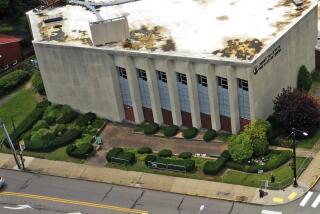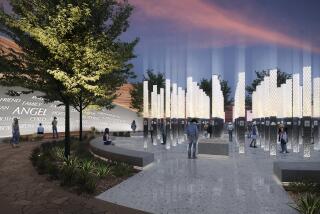Work Finally Begins on WWII Memorial
- Share via
WASHINGTON — After eight years of high hopes and often bitter controversy, work finally began Monday on the future site of a World War II memorial on the U.S. capital’s historic National Mall.
Unlike the fanfare surrounding a gala ceremonial groundbreaking late last year, a three-man surveying team and a couple of pickup trucks were the only signs that anything was afoot at the contested site between the Washington Monument and Lincoln Memorial.
The historic pool that will be reconstructed several feet below the level of the Mall as the centerpiece of the new $160-million memorial stood empty except for a threesome of ducks in a lingering puddle.
Officials were not available to comment on whether it was drained as a routine event or as part of site preparation.
“It’s been a long road to get to this point,” said Mike Conley, a spokesman for the American Battle Monuments Commission, which is coordinating the work.
“We’re very pleased that the day has finally arrived that we actually have work beginning toward the actual construction of the memorial.”
The team will spend the next week surveying the site and mapping new utilities before fences are erected and project trailers and temporary parking are installed, Conley said.
He said it would probably be the end of September before actual digging and foundation work got underway for the memorial, which opponents say will ruin the symbolic grassy promenade and the clear view between existing memorials.
The commission said the memorial--which will feature a ring of linked granite columns, arches, metal sculptures and gold stars--is scheduled to be completed in February 2004 and dedicated that spring.
Controversy, which has dogged the project for much of the planning process, continues to hang over it.
A judge will hold a hearing Friday on a plea by the National Coalition to Save Our Mall for an injunction to stop work at the site. The coalition also wants to appeal a previous lawsuit against the memorial, which was thrown out by U.S. District Judge Henry Kennedy earlier this month.
But the memorial, authorized by Congress in 1993 and designed by Austrian-born architect Friedrich St. Florian, has its champions.
Kennedy’s ruling followed legislation passed by Congress in May and signed by President Bush allowing expedited construction and seeking to nullify the coalition’s lawsuit.
Veterans groups have said it is high time to honor the 16 million Americans who served in the war, and the 400,000 who died while fighting in it.
But the coalition, which backs a memorial in principle, has challenged everything from the site and design, to the German links of the construction firms and whether plans are adequate for disposing of arsenic-contaminated ground water.
The monuments commission said the prominent site is the most fitting and rejected the other charges.
More to Read
Sign up for Essential California
The most important California stories and recommendations in your inbox every morning.
You may occasionally receive promotional content from the Los Angeles Times.










